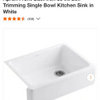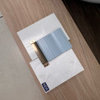question about "glass test"
Kitchen_ Reno
10 years ago
Related Stories

REMODELING GUIDESConsidering a Fixer-Upper? 15 Questions to Ask First
Learn about the hidden costs and treasures of older homes to avoid budget surprises and accidentally tossing valuable features
Full Story
DOORS5 Questions to Ask Before Installing a Barn Door
Find out whether that barn door you love is the right solution for your space
Full Story
LIGHTING5 Questions to Ask for the Best Room Lighting
Get your overhead, task and accent lighting right for decorative beauty, less eyestrain and a focus exactly where you want
Full Story
WORKING WITH PROS12 Questions Your Interior Designer Should Ask You
The best decorators aren’t dictators — and they’re not mind readers either. To understand your tastes, they need this essential info
Full Story
KITCHEN DESIGN9 Questions to Ask When Planning a Kitchen Pantry
Avoid blunders and get the storage space and layout you need by asking these questions before you begin
Full Story
MOST POPULARThe Right Way to Test Paint Colors
Here are 5 key steps to take to ensure you're happy with your wall paint color
Full Story
TASTEMAKERS5 Questions From ICFF: Lindsey Adelman
The inventive designer takes a break from New York's International Contemporary Furniture Fair to talk about her artistic lighting fixtures
Full Story
GREEN BUILDINGConsidering Concrete Floors? 3 Green-Minded Questions to Ask
Learn what’s in your concrete and about sustainability to make a healthy choice for your home and the earth
Full Story
REMODELING GUIDES9 Hard Questions to Ask When Shopping for Stone
Learn all about stone sizes, cracks, color issues and more so problems don't chip away at your design happiness later
Full Story
ORGANIZINGPre-Storage Checklist: 10 Questions to Ask Yourself Before You Store
Wait, stop. Do you really need to keep that item you’re about to put into storage?
Full Story









CEFreeman
Kitchen_ RenoOriginal Author
Related Professionals
Brownsville Kitchen & Bathroom Designers · Lenexa Kitchen & Bathroom Designers · Peru Kitchen & Bathroom Designers · Piedmont Kitchen & Bathroom Designers · Vineyard Kitchen & Bathroom Designers · West Virginia Kitchen & Bathroom Designers · Covington Kitchen & Bathroom Designers · Grain Valley Kitchen & Bathroom Remodelers · Dearborn Kitchen & Bathroom Remodelers · Jacksonville Kitchen & Bathroom Remodelers · Middletown Cabinets & Cabinetry · Newcastle Cabinets & Cabinetry · Reading Cabinets & Cabinetry · Wadsworth Cabinets & Cabinetry · Santa Paula Tile and Stone ContractorsCEFreeman
karin_mt
kevdp4
Kitchen_ RenoOriginal Author
Cloud Swift
windycitylindy
karin_mt